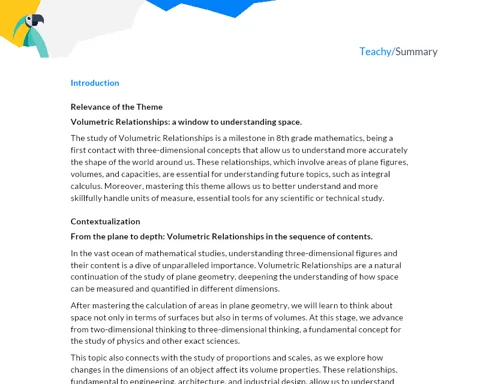Introduction
Relevance of the Topic
The area of plane figures is one of the main pillars of Geometry and Mathematics in general. Understanding how to calculate the area of figures, particularly the rectangle and parallelogram, is essential for progress in many subsequent topics, such as volume and surface area in Three-Dimensional Geometry, and even in calculus topics like integrals.
Contextualization
Calculating the area of rectangles and parallelograms fits into a broader study of plane figures. After understanding the concepts of point, line, line segment, chords and secants, polygons, and polyhedra, the need arises to measure the area of these figures. Rectangles and parallelograms are initial study figures because they have an important characteristic: they are geometric figures with parallel sides structured on the same study base. This allows for a more consistent conceptual construction that can be applied to other more complex figures. Additionally, this area is one of the first solid concepts that 7th-grade students encounter, being a fundamental piece in the construction of their mathematical thinking.
Theoretical Development
Components
-
Elements of the Rectangle and Parallelogram: Both are four-sided polygons, with equal opposite sides and equal opposite interior angles. In the rectangle, all angles are right angles (90°), while in the parallelogram, the angles can be greater or less than 90°.
-
Base and Height: In the rectangle, the base and height are any two adjacent sides perpendicular to each other. While in the parallelogram, the base is any of its sides and the height is the perpendicular distance between the base and the opposite side. The calculation of the area of these plane figures crucially depends on the base and height.
-
Area Formula: For the rectangle, the area formula is simple, being the product of the base by the height (A = b * h), where 'b' is the base and 'h' is the height. In the parallelogram, the area formula remains the same, A = b * h, but with a particularity: the base and height must always be measured in the same unit, as, unlike the rectangle, the height is not necessarily perpendicular to the base.
Key Terms
-
Area: Measure of the region contained within the boundaries of a plane figure. In the present context, the area always refers to the rectangle or parallelogram.
-
Adjacent Side(s): Those that are next to each other.
-
Opposite Side(s): Those that do not share a vertex.
-
Interior Angle(s): Formed by two consecutive sides of a polygon.
-
Right Angle(s): An angle whose measure is exactly 90°.
Examples and Cases
-
Example of Calculating the Area of a Rectangle: Suppose a rectangle with a base measuring 5 cm and a height measuring 3 cm. The area of this rectangle is calculated using the formula A = b * h, that is, A = 5 * 3 = 15 cm².
-
Example of Calculating the Area of a Parallelogram: Imagine a parallelogram with a base of 8 meters and a height of 4 meters. Using the formula A = b * h, the area of this parallelogram would be 8 * 4 = 32 square meters. Note that the measurement of the base and height must always be in the same unit.
-
Application in Everyday Life: The techniques learned to calculate the area of these figures can be applied in various practical situations, such as calculating the area of a plot of land, the amount of grass needed to cover a garden, or even calculating the space in a room for furniture distribution.
Detailed Summary
Key Points
-
Regular Polygons: Rectangles and parallelograms are classified as regular polygons with four sides. They have specific characteristics in terms of side lengths and angles that facilitate area calculation.
-
Composition: The area of rectangles and parallelograms is determined by the product of the base and height. The base is a side of the polygon, while the height is the perpendicular distance between the base and the opposite side.
-
Generalization of the Area Formula: The formula for calculating the area of a rectangle (A = b * h) is the same as that used for the parallelogram. However, it is important to note that the rectangle is a special form of parallelogram, in which all angles are right angles.
-
Relation to Other Geometries: The concept of area is fundamental in geometry because it serves as the basis for many other calculations, such as volume and surface area.
Conclusions
-
Standardization in Measurement: The importance of measuring the base and height carefully, always in the same unit of measurement, is crucial to obtain an accurate result when calculating the area of the parallelogram.
-
Generalization of Concepts: The study of the area of rectangles and parallelograms provides a basis for understanding more complex concepts, such as the area of three-dimensional figures and integration in calculus.
Exercises
- Calculating the Area of the Rectangle: For a rectangle with a base measuring 7 cm and a height measuring 9 cm, calculate its area.
- Calculating the Area of the Parallelogram: If a parallelogram has a base of 12 meters and a height of 8 meters, what is its area?
- Application in Everyday Life - Think of an example from everyday life where calculating the area of a rectangle or parallelogram would be necessary. Explain the scenario and the process you would use to make the calculation.



